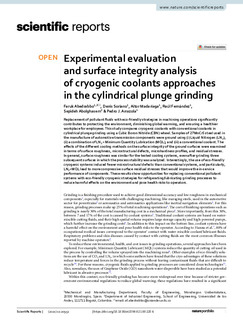| dc.rights.license | Attribution 4.0 International | * |
| dc.contributor.author | Abedrabbo Hazbun, Anibal Faruk | |
| dc.contributor.author | Soriano Moreno, Denis | |
| dc.contributor.author | Madariaga, Aitor | |
| dc.contributor.author | Fernandez Manchado, Raul | |
| dc.contributor.author | ARRAZOLA, PEDRO JOSE | |
| dc.contributor.other | Abolghasem, Sepideh | |
| dc.date.accessioned | 2021-10-29T12:12:54Z | |
| dc.date.available | 2021-10-29T12:12:54Z | |
| dc.date.issued | 2021 | |
| dc.identifier.issn | 2045-2322 | en |
| dc.identifier.other | https://katalogoa.mondragon.edu/janium-bin/janium_login_opac.pl?find&ficha_no=165245 | en |
| dc.identifier.uri | https://hdl.handle.net/20.500.11984/5406 | |
| dc.description.abstract | Replacement of pollutant fuids with eco-friendly strategies in machining operations signifcantly contributes to protecting the environment, diminishing global warming, and ensuring a healthier workplace for employees. This study compares cryogenic coolants with conventional coolants in cylindrical plunge grinding using a Cubic Boron Nitride (CBN) wheel. Samples of 27MnCr5 steel used in the manufacture of automotive transmission components were ground using (i) Liquid Nitrogen (LN2), (ii) a combination of LN2 +Minimum Quantity Lubrication (MQL), and (iii) a conventional coolant. The efects of the diferent cooling methods on the surface integrity of the ground surfaces were examined in terms of surface roughness, microstructural defects, microhardness profles, and residual stresses. In general, surface roughness was similar for the tested cooling systems, even after grinding three subsequent surfaces in which the process stability was analyzed. Interestingly, the use of eco-friendly cryogenic systems induced fewer microstructural defects than conventional systems, and particularly, LN2+MQL lead to more compressive surface residual stresses that would improve the in-service performance of components. These results show opportunities for replacing conventional pollutant systems with eco-friendly cryogenic strategies for refrigerating/lubricating grinding processes to reduce harmful efects on the environment and pose health risks to operators. | en |
| dc.description.sponsorship | Comisión Europea | es |
| dc.language.iso | eng | en |
| dc.publisher | Nature Publishing Group | en |
| dc.rights | © 2021 The authors | en |
| dc.rights.uri | http://creativecommons.org/licenses/by/4.0/ | * |
| dc.title | Experimental evaluation and surface integrity analysis of cryogenic coolants approaches in the cylindrical plunge grinding | en |
| dc.type | http://purl.org/coar/resource_type/c_6501 | |
| dcterms.accessRights | http://purl.org/coar/access_right/c_abf2 | en |
| dcterms.source | Scientific Reports | en |
| local.contributor.group | Mecanizado de alto rendimiento | es |
| local.description.peerreviewed | true | en |
| local.identifier.doi | https://doi.org/10.1038/s41598-021-00225-6 | en |
| local.relation.projectID | info:eu-repo/grantAgreement/EC/RFCS/RFCS-2018-847284/Improvement of the fatigue performance of automotive components through innovative ecofriendly finishing operations/FATECO | en |
| local.rights.publicationfee | APC | en |
| local.rights.publicationfeeamount | 1690 EUR | en |
| local.contributor.otherinstitution | https://ror.org/02h1b1x27 | es |
| local.source.details | Vol. 11. N. artículo 20952, 2021 | en |
| oaire.format.mimetype | application/pdf | |
| oaire.file | $DSPACE\assetstore | |
| oaire.resourceType | http://purl.org/coar/resource_type/c_6501 | en |
| oaire.version | http://purl.org/coar/version/c_970fb48d4fbd8a85 | en |








